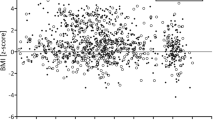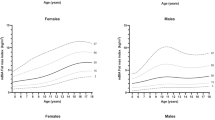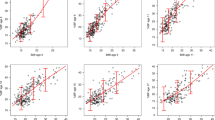Abstract
OBJECTIVE:
Most body composition techniques assume constant properties of the fat-free mass (FFM), such as hydration, density and mineralisation. Previous studies suggested that FFM composition may change in childhood obesity; however, this issue has not been investigated in detail.
AIM:
To compare FFM composition in obese and nonobese children.
DESIGN:
Observational matched case–control analyses.
SUBJECTS:
A total of 28 obese children (13 boys, 15 girls) and 22 nonobese children (10 boys, 12 girls) aged 7–14 y. Obesity was defined as body mass index centile >95.
METHODS:
Measurements were made of weight, height, total body water, and body volume. Bone mineral content was estimated in a subsample. Body composition was calculated using three- and four-component models.
RESULTS:
According to the three-component model (n=22 matched pairs), obese children had greater hydration (P<0.05), and reduced density (P=0.057) of FFM. According to the four component model (n=11 pairs), obese children had greater hydration (P<0.01) and reduced density (P<0.002) of FFM. The mineralisation of FFM was increased, but not significantly so.
CONCLUSION:
The greater hydration and reduced density of FFM of obese children should be taken into account if body composition is to be measured with optimum accuracy during treatment programmes. These differences may be addressed by using multicomponent rather than two-component models of body composition. Although the greater mineralisation of FFM in obese children was not significant in the present study, the four-component model is best able to address the combined differences in hydration and mineralisation that occur in childhood obesity.
This is a preview of subscription content, access via your institution
Access options
Subscribe to this journal
Receive 12 print issues and online access
$259.00 per year
only $21.58 per issue
Buy this article
- Purchase on Springer Link
- Instant access to full article PDF
Prices may be subject to local taxes which are calculated during checkout
Similar content being viewed by others
References
Bennett N, Dott T, Flatley J, Freeth S, Bolling K . Health survey for England 1993. London, HMSO, 1995.
Reilly JJ, Dorosty AR . Epidemic of obesity in UK children. Lancet 1999; 354: 1874–1875.
Cole, TJ, Freeman JV, Preece MA . Body mass index reference curves for the UK, 1990. Arch Dis Child 1995; 73: 25–29.
Cole TJ, Bellizzi MC, Flegal KM, Dietz WH . Establishing a standard definition for child overweight and obesity worldwide: international survey. BMJ 2000; 320: 1240–1243.
Wells JCK . A Hattori chart analysis of body mass index in infants and children. Int J Obes Relat Metab Disord 2000; 24: 325–329.
Wells JCK, Coward WA, Cole TJ, Davies PSW . The contribution of fat and fat-free tissue to body mass index in contemporary children and the reference child. Int J Obes Relat Metab Disord 2002; 26: 1323–1328.
Reilly JJ, Savage SAH, Ruxton CHS, Kirk TR . Assessment of obesity in a community sample of prepubertal children. Int J Obes Relat Metab Disord 1999; 23: 217–219.
Maynard LM, Wisemandle W, Roche AF, Chumlea WC, Guo SS, Siervogel RM . Childhood body composition in relation to body mass index. Pediatrics 2001; 107: 344–350.
Nielsen DH, Cassady SL, Janz KF, Cook JS, Hansen JR Wu YW . Criterion methods of body composition analysis for children and adolescents. Am J Hum Biol 1993; 5: 211–223.
Hewitt MJ, Going SB, Williams DB, Lohman TG . Hydration of the fat-free mass in children and adults: implications for body composition assessment. Am J Phys 1993; 265: E88–E95.
Wells JCK, Fuller NJ, Dewit O, Fewtrell MS, Elia M, Cole TJ . Four-component model of body composition in children: density and hydration of fat free mass and comparison with simpler models. Am J Clin Nutr 1999; 69: 904–912.
Fomon S, Haschke F, Ziegler EE, Nelson SE . Body composition of reference children from birth to age 10 years. Am J Clin Nutr 1982; 35: 1169–1175.
Haschke F . Body composition during adolescence. In: 98th Ross conference on pediatric research, ‘Body composition in infants and children’. Ross Laboratories: Columbus, OH; 1989. pp 76–83.
Fuller NJ, Jebb SA, Laskey MA, Coward WA, Elia M . Four-component model for the assessment of body composition in humans: comparison with alternative methods, and evaluation of the density and hydration of fat-free mass. Clin Sci 1992; 82: 687–693.
Bray GA, DeLany JP, Harsha DW, Volaufova J, Champagne CC . Body composition of African American and white children: a 2 year follow-up of the BAROC study. Obes Res 2001; 9: 605–621.
Goulding A, Taylor RW, Jones IE, McAuley KA, Manning PJ, Williams SM . Overweight and obese children have low bone mass and area for their weight. Int J Obes Relat Metab Disord 2000; 24: 627–632.
Fischer S, Milinarsky A, Giadrosich V, Dib G, Arriagada M, Arinoviche R . X-ray absorptiometry of bone in obese and eutrophic children from Valparaiso, Chile. J Rheumatol 2000; 27: 1294–1296.
Freeman JV, Cole TJ, Chinn S, Jones PRM, White EM, Preece MA . Cross sectional stature and weight reference curves for the UK, 1990. Arch Dis Child 1995; 73: 17–24.
Wells JCK, Fuller NJ, Wright A, Fewtrell MS, Cole TJ . Evaluation of air-displacement plethysmography in children aged 5–7 years using a three-component model of body composition. Br J Nutr 2003; 90: 699–707.
Wells JCK, Fuller NJ . Precision of measurement and body size in whole-body air-displacement plethysmography. Int J Obes Relat Metab Disord 2001; 25: 1161–1167.
Siri WE . The gross composition of the body. Adv Biol Med Phys 1956; 4: 239–280.
Lohman TG . Assessment of body composition in children. Ped Exerc Sci 1989; 1: 19–30.
Brozek J, Grande F, Anderson JT, Keys A . A densitometric analysis body composition: revision of some quantitative assumptions. Ann NY Acad Sci 1963; 110: 113–140.
Wong WW, Hergenroeder AC, Stuff JE, Butte NF, Smith EO, Ellis KJ . Evaluation body fat in girls and female adolescents: advantages and disadvantages of dual-energy X-ray absortiometry. Am J Clin Nutr 2002; 76: 384–389.
Moreno LA, Fleta J, Sarria A, Rodriguez G, Bueno M . Secular increases in body fat percentage in male children of Zaragoza, Spain, 1980–1995. Prev Med 2001; 33: 357–363.
Owens S, Gutin B, Allison J, Riggs S, Ferguson M, Litaker M, Thompson W . Effect of physical training on total and visceral fat in obese children. Med Sci Sports Exerc 1999; 31: 143–148.
Waki M, Kral JG, Mazariegos M, Wang J, Pierson RN, Heymsfield SB . Relative expansion of extracellular fluid in obese vs nonobese women. Am J Physiol 1991; 261: E199–E203.
Van Marken Lichtenbelt WD, Fogelholm M . Increased extracellular water compartment, relative to intracellular water compartment, after weight reduction. J Appl Physiol 1999; 87: 294–298.
Battistini N, Virgili F, Severi S, Brambilla P, Manzoni P, Beccaria L, Chiumello G . Relative expansion of extracellular water in obese vs normal children. J Appl Physiol 1995; 79: 94–96.
Leone PA, Gallagher D, Wang J, Heymsfield SB . Relative overhydration of fat-free mass in postobese vs never-obese subjects. Ann NY Acad Sci 2000; 904: 514–519.
Van Lenthe FJ, Kemper CG, van Mechelen W . Rapid maturation in adolescence results in greater obesity in adulthood: the Amsterdam Growth and Health Study. Am J Clin Nutr 1996; 64: 18–24.
Whiting SJ . Obesity is not protective for bones in childhood and adolescence. Nutr Rev 2002; 60: 27–30.
Kain J, Albala C, Garcia F, Andrade M . Obesity in Chilean preschool children: anthropometric evolution and socioeconomic determinants. Rev Med Chil 1998; 126: 271–278.
Skaggs DL, Loro ML, Pitukcheewanont P, Tolo V, Gilsanz V . Increased body weight and decreased radial cross-sectional dimensions in girls with forearm fractures. J Bone Miner Res 2001; 16: 1337–1342.
Goulding A, Jones IE, Taylor RW, Williams SM, Manning PJ . Bone mineral density and body composition in boys with distal forearm fractures: a dual-energy x-ray absorptiometry study. J Pediatr 2001; 139: 509–515.
Goulding A, Cannan R, Williams SM, Gold EJ, Taylor RW, Lewis-Barned NJ . Bone mineral density in girls with forearm fractures. J Bone Miner Res 1998; 13: 143–148.
Barbeau P, Gutin B, Litaker M, Owens S, Riggs S, Okuyama T . Correlates of individual differences in body-composition changes resulting from physical training in obese children. Am J Clin Nutr 1999; 69: 705–711.
Tothill P, Avenell A, Reid DM . Precision and accuracy of measurements of whole-body bone mineral: comparisons between Hologic, Lunar and Norland dual-energy X-ray absorptiometers. Br J Radiol 1994; 67: 1210–1217.
Acknowledgements
We are very grateful to Dr Dasha Nicholls of Great Ormond Street Hospital, Paul Sacher of the MEND clinic, and Professor David Candy and Heidi Bennet of the Leaf Clinic, Chichester, for assistance with recruitment of patients.
Author information
Authors and Affiliations
Corresponding author
Rights and permissions
About this article
Cite this article
Haroun, D., Wells, J., Williams, J. et al. Composition of the fat-free mass in obese and nonobese children: matched case–control analyses. Int J Obes 29, 29–36 (2005). https://doi.org/10.1038/sj.ijo.0802834
Received:
Revised:
Accepted:
Published:
Issue Date:
DOI: https://doi.org/10.1038/sj.ijo.0802834
Keywords
This article is cited by
-
Changes in the body composition of boys aged 11–18 years due to COVID-19 measures in the Czech Republic
BMC Public Health (2022)
-
Associations of age and body mass index with hydration and density of fat-free mass from 4 to 22 years
European Journal of Clinical Nutrition (2019)
-
Effects of interventions with a physical activity component on bone health in obese children and adolescents: a systematic review and meta-analysis
Journal of Bone and Mineral Metabolism (2018)
-
Methodologies to assess paediatric adiposity
Irish Journal of Medical Science (1971 -) (2015)
-
Influence of lean and fat mass on bone mineral density and on urinary stone risk factors in healthy women
Journal of Translational Medicine (2013)



